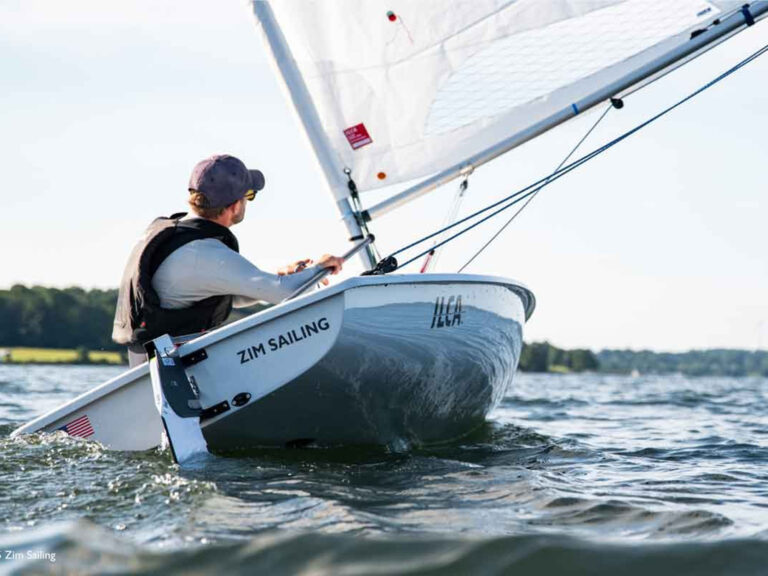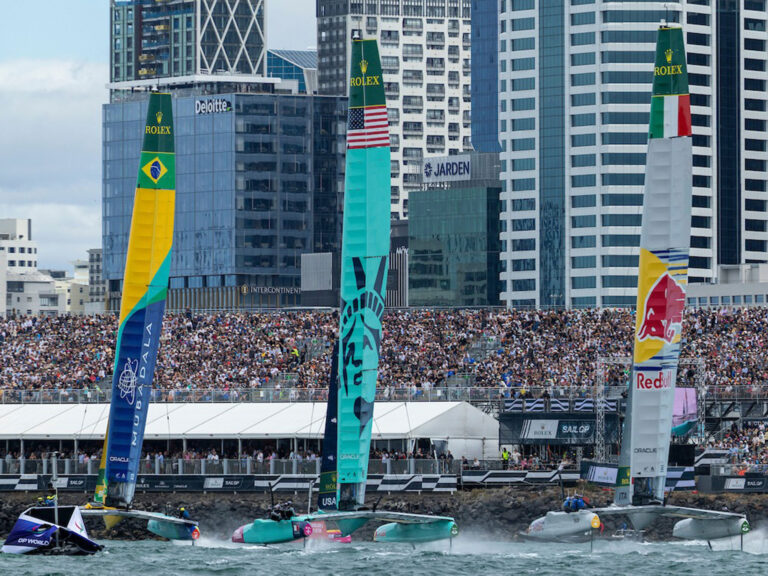
onboard Speedboat 368
The wiry Kiwi, the one who wore his miles at sea in the many lines on his face and the streaks of grey in his hair, put it best. “This boat,” he said as we barreled upwind at 12 knots, making a near gale out of the light seabreeze, “she’ll put the fear of God in you, she will.”
It was more of a thank-God day last June when I went for a sail on Speedboat, Alex Jackson’s 99-foot supermaxi, which has since been wrapped in red and renamed Virgin Money Speedboat through a sponsorship deal. The sun was shining and the breeze was just starting to kick up the chop offshore. But even in such benign conditions there was plenty to indicate that the veteran deckhand wasn’t exaggerating one bit.
The phrase “blank slate” is often thrown around when it comes to custom craft. But rarely has it been applied more accurately than with the brief given to yacht designer Juan Kouyoumdjian, an Argentine who spends as much time thinking outside the box as in it.
“Alex was very clear at the beginning that he wanted a fast and fun boat that pushes the limits of what monohulls have been doing so far, but without reinventing the wheel,” says Kouyoumdjian. “So he said, ‘Can we collect everything you know from the Volvos and anything else without having to reinvent anything? Can we just collect it on a 100-footer and have fun?’ I said, ‘Yeah, I think we can do that.'”
The only real limit, the length, was set in part to meet entry requirements for such races as the Sydney Hobart, Transpac, and Newport to Bermuda. However, says Kouyoumdjian, had he been given the green light to go bigger, he probably wouldn’t have.
“It’s very easy to go past this line where you end up having everything custom and then the expenses go very big for not a real increase in performance,” he says. “In fact, having done this exercise, I don’t think anything bigger than 100, 105-footer is any faster right now.”
Mike Sanderson, the racing skipper for Virgin Money Speedboat, was heavily involved with the design and build of Mari-Cha IV, a 146-foot schooner that broke the transatlantic monohull record in 2003. At the time Mari-Cha IV was conceived, the design team considered three options-a 100-foot sloop, a 120-foot ketch, and a 140-foot schooner-each the maximum size allowed by the available technology.
The schooner won. However, says Sanderson, that wouldn’t be the case today. “Times have changed, the equipment’s different, composite rigging is very much the norm,” he says, “and the 100-foot sloop, in our opinion, is the way to go.”
Along with Kouyoumdjian and Sanderson-perhaps the most qualified person in the world for this sort of boat given his win in the last Volvo Ocean Race and his experience with Mari Cha III and Mari Cha IV-other key figures in the construction process included trimmer and deck layout guru Robbie Naismith, Cookson Boat Builders in New Zealand, and project manager Bill Erkelens, a veteran of Larry Ellison’s Sayonara campaign.
The result is a new breed of supermaxi. Like Mike Slade’s ICAP Leopard, it has the width and power of a Volvo 70 scaled up to 100 feet. But unlike Leopard, there’s no semblance of a comfortable interior on Speedboat, or any allowances for one to ever be put in. In fact, a pair of bulkheads divides the interior in half, the forward portion serving as a massive sail locker. The living space for the two-dozen-plus crew is crammed into the middle third of the boat. Everything on Speedboat is there to make the boat go faster. At least the name isn’t false advertising.
After initial sea trials on the Hauraki Gulf, Speedboat was shipped to Newport to prepare for its debut in the New York YC’s Annual Regatta and the Bermuda Race. A day before its first race, I joined the crew for a day of training.
Once on board, it doesn’t take too long to get used to the size. In many obvious respects, it’s like any other race boat, just larger. But this level of comfort was fleeting.
The deck, for example, is cambered, the rail chamfered to save weight. The winch drums feature two-stage non-skid to aid with the easing of loaded sheets and halyards. The 14-foot bowsprit, which has the maximum girth of an offensive lineman, is integral to the hull.
Getting the main up requires two halyards-one for either end of the massive flat-top head-and two men aloft. Getting the headsail of choice out of the hold requires five burly grinders and a halyard.
Once we unfurl the Code Zero-a $200,000 sail according to one crewmember-and we are sailing upwind with the speedo comfortably in double digits, I join the 20 or so crew not involved with the sailing the boat on the rail, our feet dangling over the massive lead bulb of the canting keel.
Moments later, the final shards of comfort evaporate with a sudden powerful bang; the sort of noise that has everyone ducking and then checking body parts. One of the titanium anchors for the outhaul ram has broken free. It’s not fatal, we’ll sail the rest of the day with a little extra depth in the mainsail. But, it serves as one final reminder that while this radical boat may have the same key components as every other sloop, it’s like nothing I’ve ever sailed.





